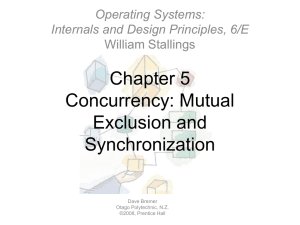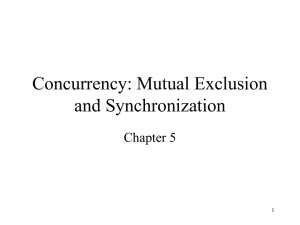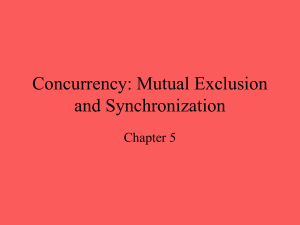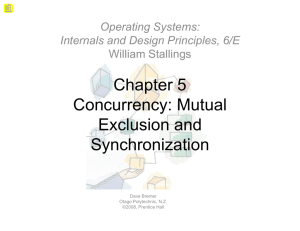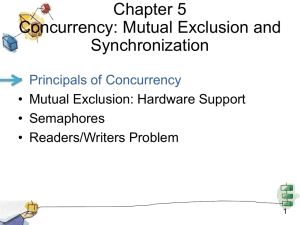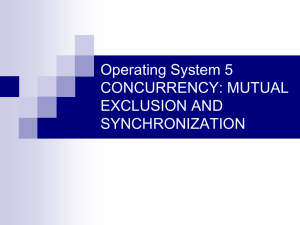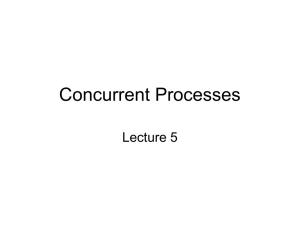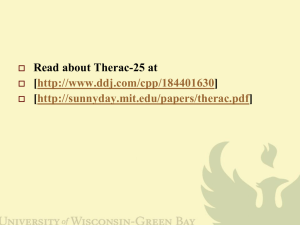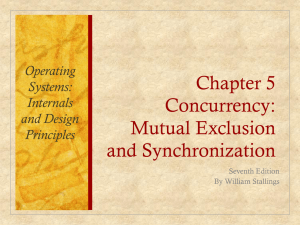Mutual Exclusion and Synchronization
advertisement
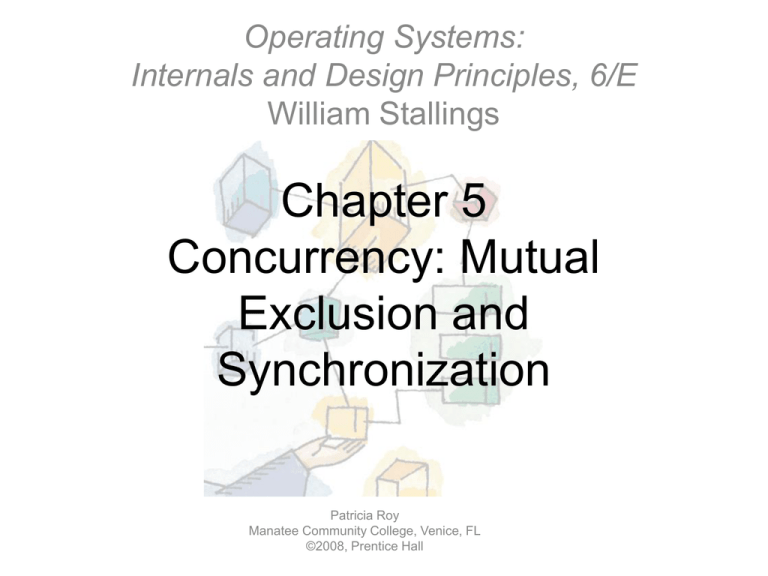
Operating Systems:
Internals and Design Principles, 6/E
William Stallings
Chapter 5
Concurrency: Mutual
Exclusion and
Synchronization
Patricia Roy
Manatee Community College, Venice, FL
©2008, Prentice Hall
Concurrency Problem: A Simple
Example
char chin, chout;
void echo()
{
chin = getchar();
chout = chin;
putchar(chout);
}
Concurrency Problem: A Simple
Example
Process P1
.
chin = getchar();
.
chout = chin;
putchar(chout);
.
.
Process P2
.
.
chin = getchar();
chout = chin;
.
putchar(chout);
.
Multiprogramming Concerns
• Output of process must be independent
of the speed of execution of other
concurrent processes
Competition among Processes
for Resources
• Mutual Exclusion
– Critical sections
• Deadlock
• Starvation
Key Terms
Race Condition Example
Process P1
.
chin = getchar();
.
chout = chin;
putchar(chout);
.
.
Process P2
.
.
chin = getchar();
chout = chin;
.
putchar(chout);
.
Requirements for Mutual
Exclusion
• Only one process at a time is allowed in
the critical section for a resource
• A process that halts in its noncritical
section must do so without interfering with
other processes
• No deadlock or starvation
Requirements for Mutual
Exclusion
• A process must not be delayed access to
a critical section when there is no other
process using it
• No assumptions are made about relative
process speeds or number of processors
• A process remains inside its critical section
for a finite time only
Mutual Exclusion Approaches
• Software approach
• Appendix A
• Hardware support, using special-purpose
machine instructions
• Support within OS or a programming
language
– Semaphore, Monitors, Message Passing
Mutual Exclusion: Hardware
Support
• Interrupt Disabling
– A process runs until it invokes an operating
system service or until it is interrupted
– Disabling interrupts guarantees mutual
exclusion
• Disadvantages:
– Processor is limited in its ability to interleave
programs
– Will not work in multiprocessor architecture
Mutual Exclusion: Hardware
Support
• Compare&Swap Instruction
int compare_and_swap (int *word, int
testval, int newval)
{
int oldval;
oldval = *word;
if (oldval == testval) *word = newval;
return oldval;
}
Mutual Exclusion
Mutual Exclusion: Hardware
Support
• Exchange instruction
void exchange (int *register, int *memory)
{
int temp;
temp = *memory;
*memory = *register;
*register = temp;
}
Mutual Exclusion
Mutual Exclusion MachineInstruction
• Advantages
– Applicable to any number of processes on a
single processor
– Processes on multiple processors?
• as long as processors share main memory
– It is simple and therefore easy to verify
– It can be used to support multiple critical
sections; each critical section can be defined
by its own variable (e.g. bolt1, bolt2, etc.)
Mutual Exclusion MachineInstruction
• Disadvantages
– Busy-waiting consumes processor time
– Starvation?
• Starvation is possible when a process leaves a
critical section and more than one process is
waiting
– Deadlock?
Semaphores
• Special variable called a semaphore is
used for signaling
• If a process is waiting for a signal, it is
suspended until that signal is sent
Semaphores
• Semaphore is a variable that has an
integer value
– May be initialized to a nonnegative number
– Wait operation decrements the semaphore
value
– Signal operation increments semaphore value
Semaphore Primitives
Example of Semaphore
Mechanism
Example of Semaphore
Mechanism
Mutual Exclusion Using
Semaphores
Mutual Exclusion Using
Semaphores
Processes Using Semaphore
Binary Semaphore Primitives
Producer/Consumer Problem
• One or more producers are generating
data and placing these in a buffer
• One or more consumers are taking items
out of the buffer one at time
• Only one producer or consumer may
access the buffer at any one time
• Producer can’t add data into full buffer and
consumer can’t remove data from empty
buffer
Buffer
Producer
• producer:
while (true) {
/* produce item v */
b[in] = v;
in++;
}
Consumer
• consumer:
while (true) {
while (in <= out)
/*do nothing */;
w = b[out];
out++;
/* consume item w */
}
Incorrect Solution
32
Correct Solution
Semaphores
Circular Buffer
Producer with Circular Buffer
• producer:
while (true) {
/* produce item v */
while ((in + 1) % n == out)
b[in] = v;
in = (in + 1) % n
}
/* do nothing */;
Consumer with Circular Buffer
• consumer:
while (true) {
while (in == out)
/* do nothing */;
w = b[out];
out = (out + 1) % n;
/* consume item w */
}
Semaphores
Semaphores
Semaphore Implementation:
Atomic Primitives
Mutual Exclusion MachineInstruction vs. Semaphore
Mutual Exclusion MachineInstruction vs. Semaphore
Mutual Exclusion Approaches
• Software approach
• Appendix A
• Hardware support, using special-purpose
machine instructions
• Support within OS or a programming
language
– Semaphore, Monitors, Message Passing
Monitor
Mutual Exclusion Approaches
• Software approach
• Appendix A
• Hardware support, using special-purpose
machine instructions
• Support within OS or a programming
language
– Semaphore, Monitors, Message Passing
Message Passing
• Enforce mutual exclusion
• Exchange information
•
•
send (destination, message)
receive (source, message)
Synchronization
• The receiver cannot receive a message
until it has been sent by another process
• What happens to a process after it issues
a send or receive primitive
– Sender and receiver may or may not be
blocked (waiting for message)
Synchronization
• Blocking send, blocking receive
– Both sender and receiver are blocked until
message is delivered
• Nonblocking send, blocking receive
– Sender continues on
– Receiver is blocked until the requested
message arrives
• Nonblocking send, nonblocking receive
– Neither party is required to wait
Addressing
• Direct addressing
– Send primitive includes a specific identifier of
the destination process
– Receive primitive may/may not know ahead of
time from which process a message is expected
– Receive primitive could use source parameter
to return a value when the receive operation
has been performed
Addressing
• Indirect addressing
– Messages are sent to a shared data structure
consisting of queues
– Queues are called mailboxes
– One process sends a message to the mailbox
and the other process picks up the message
from the mailbox
Indirect Process
Communication
General Message Format
Mutual Exclusion Using
Messages (1)
• Assume
– blocking receive primitive
&
– nonblocking send primitive
Mutual Exclusion Using
Messages (2)
Producer/Consumer Messages
Readers/Writers Problem
• Any number of readers may simultaneously
read the file
• Only one writer at a time may write to the
file
• If a writer is writing to the file, no reader
may read it
• How is this problem different from mutual
exclusion problem?
• Cast it to a mutual exclusion problem?
Any Problem with This Solution?
Readers have Priority
Writers Have Priority
• The following semaphores and variables are
added:
– A semaphore rsem that inhibits all readers while
there is at least one writer desiring access to the
data area
– A variable writecount that controls the setting of
rsem
– A semaphore y that controls the updating of
writecount
– A semaphore z that prevents a long queue of
readers to build up on rsem
Writers have Priority
Writers have Priority
Writers have Priority
Message Passing
Note: count is initialized to the maximum
possible number of readers, e.g., 100.
